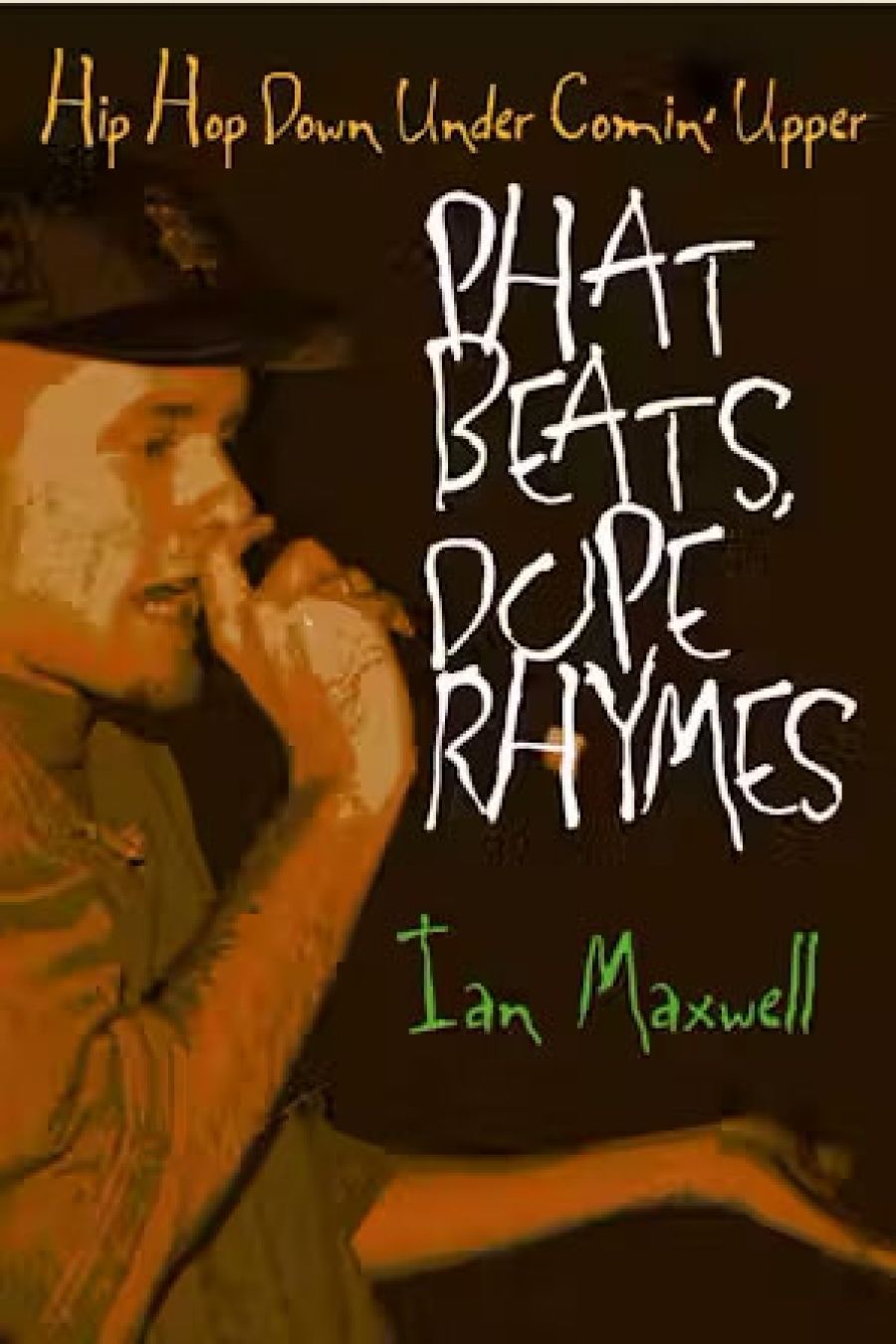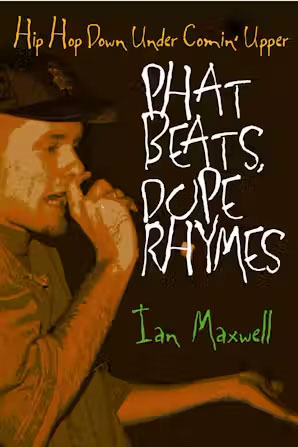
- Free Article: No
- Contents Category: Cultural Studies
- Review Article: Yes
- Online Only: No
- Custom Highlight Text:
It is impossible to look cool studying youth culture. Researchers can’t help being uncool, whether they’re explaining every little term to their readers, as if to a High Court judge, or shoehorning the ‘in’ lingo into their otherwise conventional academic texts. However advanced their self-awareness strategies or their desire to avoid seeming preachy, nothing can stop them coming off like T-shirted versions of the social surveyors of a century ago. Instead of the slums or Samoa, it’s some kind of sweaty, fertile, animalistic netherworld of tribal signs and tracksuit brand logos.
- Book 1 Title: Ingenious
- Book 1 Subtitle: Emerging youth cultures in Australia
- Book 1 Biblio: Pluto Press, $29.95pb, 219pp
- Book 2 Title: Phat Beats, Dope Rhymes
- Book 2 Subtitle: Hip Hop down under comin' upper
- Book 2 Biblio: Wesleyan University Press, $22.95pb. 295pp
- Book 2 Cover Small (400 x 600):

- Book 2 Cover (800 x 1200):

Indigenous is a collection of essays on various aspects of youth culture, based on a study of the contribution of ‘young people of migration heritage’ to Sydney’s dynamic culture, made under the umbrella GENERATE. Most of its pages concentrate on ethnic sectors of the western suburbs of Sydney. Various cultural exchanges and beliefs are considered, a number of them novel: types of interaction amongst Turkish, Lebanese and Vietnamese teens in Internet chat rooms, for instance. The creative customisation of computers, the status value of cars, and many more elements of teen life in and between various ethnic groups and subgroups are countenanced in what is, overall, an exotic and often fascinating array of angles. If the researchers seem far too keen to take informants on face value (Mandy Thomas and Melissa Butcher’s interview with twenty-one-year-old Hiba, for instance, reveals that any girl will get into any car whoever is driving it, as long as it looks good enough), their interviews are nevertheless pertinent and revealing of some young people’s attitudes and responses across a range of new challenges. Just bring a pinch of scepticism.
Elsewhere, Shane Homan takes on suburban rock, and Tony Mitchell covers indigenised (or, rather, local) hip hop in a chapter that provides a valuable update on (while quoting extensively from) work undertaken by Ian Maxwell, who teaches Performance Studies at the University of Sydney. Maxwell must have felt mixed emotions when Wesleyan University Press offered to publish his 1997 PhD thesis, Phat Beats, Dope Rhymes. Hip hop is a fast-moving scene, and, while Phat Beats was a cutting-edge, contemporary study when concocted in the early 1990s, it has now become a period piece.
Maxwell’s portrait of one (Sydney-based) hip hop clique begins intriguingly with an encounter between battling rappers in Radio Skid Row’s studios in 1994. Personalities, loyalty to the scene, individual skills – it’s a word sport – are all foregrounded as issues. Maxwell’s subsequent analysis of hip hop’s Sydney version, not an African-American statement but a self-defining, multi-racial, local subculture always aware of its position in a global context, is undoubtedly valuable – there is not enough work being done on Australian reactions to global appropriated and/or ‘enforced’ cultures. He also goes in-depth on the graffiti scene and its ‘writers’, and on their connections to music. But Mitchell’s chapter in Indigenous makes it clear how old this material is. And it’s not only old, it’s set in amber: there is no reflection of the changes wrought on the ‘scene’ by, for instance, the now ubiquitous Internet, or the availability of cheaper digital home recording, changes in mainstream perceptions of hip hop and related music, or, for that matter, the NSW government’s ‘tough on crime’ initiatives, so often seen as anti-youth culture. These things should have been discussed, somewhere.
In fact, the one concession Maxwell docs make to the world beyond 1994 is a simplistic history of Australia reflected through the 2000 Olympics opening ceremony, in one of four introductory sections that take up the book’s first fifty pages. This discussion is peculiar in this context, as so much of Phat Beats goes towards showing Maxwell’s very valid contention that hip hop is/was not inherently racially based in Australia, and – this is obvious – that it is no more or less relevant to Aboriginal people than it is to any other disenfranchised and/or ‘outsider’ sector in this country. Later, Maxwell outlines ‘the trope of the Hip Hop Nation’ emerging as ‘a mechanism through which this process of identification with geographical, racial and cultural “others” can be negotiated. The imaginary Hip Hop Nation is predicated on a shared “otherness”, rather than on a continuity of “national, ethnic, local, class or trade-specific identities”‘ : a reasonable assertion, and an important point to make in a cultural context where it is often assumed that hip hop in Australia is all about white people ‘wanting to be black’. Aboriginality fits awkwardly in Maxwell’s text, and it is not easy to understand why he keeps bringing it up.
Sometimes Maxwell goes too far. In exploring the writings of self-published hip hop commentator Blaze, he quotes Blaze’s breathless proclamation that hip hop is ‘probably the most accepting racially diverse culture that exists today’. Putting aside the fact that any reference to ‘today’ is a furphy in a book dedicated to events of a decade ago this is definitely a statement needing more discussion from Maxwell. He also, incidentally, repeats Blaze’s claim twice on two consecutive pages, a proofing error that, while minor in itself, reflects the way the ‘cultural-racial’ slant has been patched-in for an American readership. (Another, related, statement is made twice in identical terms in the book’s opening paragraph!)
One more aspect of both Phat Beats and Ingenious needs to be addressed, a problem in an increasing number of Australian academic texts: geography. Both works purport, in their subtitles, to be studies of youth cultures in urban Australia. They are not: they’re studies from Sydney, the largest, most globally connected city in Australia. The suggestion that Sydney can stand in for ‘generic urban Australia’ is probably less a matter of outright Sydneycentrism and more a symptom of the tendency amongst publishers to shy away from anything that signals an overly local flavour, at least when it comes to the marketing or packaging of academic books. It is clearly of no use to any researcher, layperson or otherwise interested party to assume that what stands in Bankstown stands in Hopper’s Crossing or Elizabeth (to pluck three examples from the air), and it is offensive to people in all those territories to assume so. This surely holds even truer in works that claim to celebrate diversity, place and ethnic groups’ responses to new environments.


Comments powered by CComment